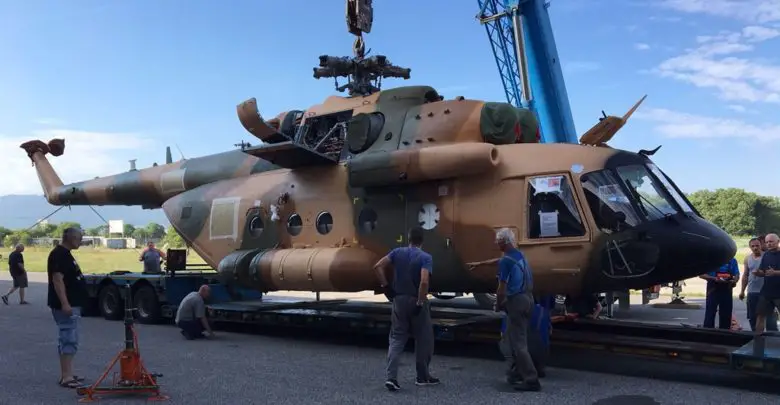
Three Afghan Mi-17 helicopters refurbished by NATO in Europe will be operational within weeks, a spokesperson for the Resolute Support mission said, as the United States continues to build the Afghan Air Force’s UH-60 Black Hawk capacity.
The Russian-made helicopters were taken for repair “at various times between 2016-2017,” and they arrived in Kabul on July 29, Resolute Support spokesperson Lieutenant Colonel Martin O’Donnell told The Defense Post.
At the request of the U.S. Department of Defense, NATO’s Support and Procurement Agency overhauled and repaired the helicopters which it said were heavily damaged and unfit for service.
NSPA managed the overhauls through contracts with various suppliers, and O’Donnell said the repairs were carried out in Bulgaria, the Czech Republic and Slovakia, all NATO member countries.
The repaired Mi-17s were all collected on July 28 by a chartered Antonov 124 heavy lift aircraft.
“Afghan maintenance personnel, under the oversight of contractors, are expected to have the helicopters ready for test flights and subsequent operations within the next few weeks,” O’Donnell said.
Two of the refurbished aircraft belong to the Afghan Air Force, and the third belongs to the Special Mission Wing, O’Donnell added.
Created and equipped by the U.S. Defense Department which continues to provide training and contractor support, the Special Mission Wing is the aviation branch of the Afghan Special Security Forces.
It supports Afghanistan’s counter-narcotics, counter-terrorism, and special operations forces, and is the only Afghan force with night-vision, helicopter assault, and fixed-wing intelligence, surveillance, and reconnaissance capabilities.

The Mi-17: a Russian-built Afghan workhorse
The Mi-17 is a medium twin-turbine multipurpose transport helicopter and is the primary rotary wing platform operated by the Afghan Air Force. The Mi-17 designation is solely for export, and in Russia it is known as the Mi-8.
It has a crew of three as well as door gunners, and can carry up to 36 troops or 12 stretchers or 18 walking patients. Rosboronexport says its range without external fuel tanks is 675 km (420 miles), its service ceiling is 6,000 m (19,700 ft), and its maximum payload weight is 4,000 kg (8,800 lb). According to a January 2018 report by the U.S. Department of Defense Inspector General, Afghan Mi-17s can carry 24 passengers and have a cargo capacity of 6,620 pounds (3,000 kg).
More than 12,000 Mi-8/Mi-17 aircraft have been manufactured and more than 2,800 have been exported for use by dozens of air forces around the world. The U.S. has purchased Russian-made Mi‑17s for the Afghan Air Force since 2005, and the Special Inspector General for Afghanistan Reconstruction (SIGAR) says that between 2011 and 2014, the U.S. procured 63 Mi-17s from Russia for the Afghan Air Force – 33 for the AAF and 30 for the Special Mission Wing.
Reuters reported in 2016 that military officials wanted to use the Mi-17 for the AAF because Afghan pilots and mechanics were already familiar with the aircraft, and the Pentagon originally planned to spend more than $1 billion on new Mi-17s. The U.S. position shifted due to pressure from Congress in 2013, and in 2014 President Barack Obama issued restrictions on doing business with Russian arms manufacturers.
The U.S. is now focused on replacing Afghanistan’s Mi-17 fleet with American-made UH-60 Black Hawks, and around two are delivered to Afghanistan every month.

Detailed public reports of declassified information from the various Inspectors General covering the U.S. mission in Afghanistan give a useful, if outdated, picture of Afghan capabilities.
In its quarterly report to the U.S. Congress published on July 30, SIGAR said that between February and April, Mi-17s flew 4,706 out of a total of 8,752 sorties, representing 54 percent of sorties flown by all Afghan aircraft.

The Mi-17 also flew the most hours of any airframe, an average of 815.5 hours per month, followed by the U.S.-supplied MD-530 Cayuse Warrior light attack helicopter at 598 hours per month.
The January DoD IG report said that Afghan National Army corps commanders knowingly exceeded monthly flying hours for Mi‑17 helicopters because policy allowed them to use the aircraft in direct support of ground forces, enabling commanders to “directly task assigned helicopters without properly regarding the aircraft’s condition and available flying hours.”
This meant that the helicopters were not undergoing required periodic inspections and maintenance, “accelerating the requirement for major maintenance at out-of-country depot maintenance locations in the Czech Republic, Bulgaria, and Slovakia.” The report said that this “will accelerate the Mi‑17 fleet’s deterioration and reduce available aircraft for operational use.”
The report redacted the order to mitigate this problem, but unredacted discussion in the report said that it established “centralized control and decentralized execution of Mi-17s” and noted that “strictly implementing that order requires assistance from coalition advisors.”

SIGAR’s July report said that that only 26 of 48 Afghan Air Force Mi-17 aircraft were available for operations – including two that were no longer unavailable since the previous quarterly report.
Information about the Special Mission Wing was not declassified for the July report, but in its January report SIGAR said that SMW had a total of 33 Mi-17s “on hand” in two variants – nine are version 1, and 24 are the newer version 5, none of which were built before 2013.
SIGAR said the Afghan Air Force U.S.-made helicopter inventory included 25 MD-530 light attack helicopters and 16 UH-60 Black Hawk utility helicopters – eight more than in the previous quarter. In September 2017, the U.S. Defense Department awarded MD Helicopters a $1.38 billion contract for the “procurement of an estimated quantity of 150 MD 530F aircraft” and related support including pilot training. The estimated completion date is 2022, and would bring the total number of Afghan MD-530s to more than 170.
The AAF also had four Russian-designed Mi-35 large attack helicopters, all of which were unavailable according to SIGAR. India supplied four Mi-24/Mi-35s to Afghanistan during 2015-16, and this year underwrote the delivery of four more refurbished Russian gunships from Belarus.
As of May 8, the Afghan Air Force had a total of 76 fully mission-qualified, or certified mission-ready Mi-17 pilots – 41 aircraft commanders and 35 copilots. The January SIGAR report said the SMW had 58 Mi-17 pilots.
The AAF also had 60 MD-530 pilots, including 20 aircraft commanders, 29 copilots, 10 instructor pilots, and one pilot not yet qualified; 13 Mi-35 attack helicopter pilots; and 15 UH-60 pilots, four of whom are aircraft commanders, and 12 pilots in training.

Black Hawks up
NATO has agreed to extend financial sustainment of the Afghan forces through 2024 and to sustain the Resolute Support mission “until conditions indicate a change in the mission is appropriate,” O’Donnell said.
The Afghan Air Force will have Mi-17s in their inventory until 2023, but the Pentagon maintains that the aircraft it is not sustainable in the long run.
“That is why the Afghan Air Force is transitioning to a U.S. platform ensuring ready support for parts and labor, as well as resident experience in providing aircrew flight instruction,” O’Donnell said.
According to a report to Congress published in May by the Lead Inspector General for Operation Freedom’s Sentinel, the U.S. mission in Afghanistan, the Afghan Air Force Mi-17 inventory is scheduled to be reduced from 47 to 20 by the end of 2019, then to 18 by the end of 2021 and 12 by the end of 2022.
The Afghan Black Hawks are refurbished ex-U.S. Army aircraft retrofitted through the Black Hawk Exchange and Sales Transaction (BEST) program and designated UH-60A+.

The first two Sikorsky UH-60s sent from U.S. Army stock were delivered to Afghanistan on September 18, 2017. By 2024 the U.S. will provide the AAF and SMW with at least 159 Black Hawks including 58 fitted with extra rocket pods and machine guns to provide close air support, Reuters reported in September. The refurbishment and upgrade costs the U.S. government around $8 million per airframe. Congress appropriated $814 million for the program in fiscal year 2017.
The program is not without controversy, with problems highlighted in particular with load capacity and the Black Hawk’s service ceiling in mountainous Afghanistan.
Sikorsky says the Black Hawk can carry 11 soldiers to the Mi-17’s 24, although if configured for maximum capacity, it can reportedly transport 20 lightly equipped personnel. Medevac variants can transport 6 medical litters. The UH-60 can carry 8,000 lbs (3,630 kg) slung below the aircraft.
The Lead Inspector General’s report said the the transition from Mi-17 to the UH-60 Black Hawk presents challenges that must be addressed.
“Black Hawks do not have the lift capacity of Mi-17s. They are unable to accommodate some of the larger cargo items the Mi-17s can carry, and in general, it takes almost two Black Hawks to carry the load of a single Mi-17. Furthermore, unlike Mi-17s, Black Hawks cannot fly at high elevations and, as such, cannot operate in remote regions of Afghanistan where Mi-17s operate.”

But Pentagon personnel dispute these conclusions.
Responding to questions about the report, Pentagon spokesperson Lieutenant Colonel Kone Faulkner told Bloomberg that Black Hawks could be used in 90 percent of the missions currently undertaken by Mi-17s. He said the UH-60 “can fly at the required mission altitudes at which the Afghan Mi-17 missions are typically flown,” and that “in many cases the UH-60 is as, or more, capable than the Mi-17.”
Brigadier General Phillip Stewart, the former Train, Advise, Assist Command-Air (TAAC-A) commander, said of the UH-60A+: “This variant has a more capable engine and transmission suite which allows it to fly at the higher elevations seen in certain parts of Afghanistan. Both platforms are adequate for the elevations in Afghanistan, and depending upon configuration, the UH-60A+ outpaces the Mi–17 in regards to altitude ceiling.”
During a June press briefing, U.S. Air Force Brigadier General Lance Bunch, assistant, deputy commanding general for Air, U.S. Forces-Afghanistan said that “the choice was made to use the UH-60A+” and that “in some instances, depending on how the UH-60 is loaded or the Mi-17 is loaded, the UH-60 actually has a better altitude or load capacity, depending on the environment.”
“The Mi-17 and the UH-60A+ have completely different flight envelopes. They’re – they’re completely different helicopters,” Bunch said. “Both helicopters work here in Afghanistan. The UH-60A+ is going to be a fantastic addition to the Afghan Air Force.”
These arguments hold water, particularly given the U.S. plan to replace the roughly 70 Russian airframes with around 160 comparable American helicopters.

Importantly, SIGAR noted that the Special Mission Wing’s Mi-17s will be “replaced with a mix of UH-60s and a small quantity of U.S.-made, heavier lift rotary wing aircraft to meet the SMW’s requirement for more lift capability than the UH-60s provide.” It said that the DoD in 2015 identified the U.S. Army’s excess CH-47 Chinook heavy lift helicopters as a possible platform to meet this requirement. As well as a much-higher lift capacity, the Chinook has a higher service ceiling.
O’Donnell said the AAF currently has 19 UH-60s, with more arriving throughout the year. SIGAR’s July report said that of the 16 aircraft in-country at the time of the report, 10 were used for pilot and aircrew training and qualification, and six for operational missions.
The AAF operates three flights per week from both Kandahar Air Field and Forward Operating Base Shorab in Helmand Province.

Black Hawk pilot training
The first six Afghan Air Force pilots qualified to pilot the UH-60 Black Hawk graduated from Aircraft Qualification Training on November 20. They all had experience flying Mi-17s, making the transition to the American aircraft relatively straightforward.
UH-60 training is ongoing at Kandahar, with 15 pilots graduating recently and 12 pilots due to graduate in early August.

On May 8, the day after the first four aircraft commanders graduated from mission qualification training, Afghan Air Force UH-60 Black Hawk helicopter crews conducted their first operational mission in Helmand Province.
The U.S. Air Force was scheduled to train 14 AAF pilots on the UH-60 in 2018 at Fort Rucker, Alabama, a further 21 in 2019, and then 25 in the following years, with four qualified crews expected by fighting season 2018, and 32 crews by fighting season 2019. UH-60 training will in future be conducted in the United States, Czech Republic and United Arab Emirates.
All Afghan pilots are taught in English rather than their native language, and according to the U.S. Air Force, the two main criteria for selection are flight physicals and English language ability. U.S. Forces-Afghanistan’s Gen. Bunch said that “as part of their initial training, they get six months of English training to start.” SIGAR’s July report says Raytheon is contracted to provide English-language training for the AAF.
The Lead Inspector General’s report said that new Mi-17 pilots continue to be trained, with 10 pilots scheduled to graduate in 2018 and a further 10 in 2019. These pilots are needed to replace Mi-17 pilots who migrate to the Black Hawk, raising concerns over the efficiency of training pilots to fly an airframe that is being phased out, rather than training the new pilots on the UH-60.
The report highlighted maintenance as a further issue with the Black Hawk, particularly due to the American platform’s relative complexity in comparison the the Russian aircraft. It said that Afghan personnel perform roughly 80 percent of the maintenance tasks on Mi-17s, with contractors undertaking the remaining 20 percent.
“The expectation is that the AAF will be almost entirely reliant on contractors for Black Hawk maintenance in the near- to mid-term,” because maintenance of the Mi-17 is “much more conducive to the education level available in the general Afghan population than the UH-60As.”
The January DoD IG report went further, saying that English comprehension is a requirement for AAF maintenance personnel.
“The original equipment manufacturers for aircraft will not convert their technical procedures or maintenance manuals into Dari or Pashtu, citing translation concerns with the non-technical nature and limited vocabulary of these languages,” the report said. “Contractors cannot translate aircraft technical manuals due to the risk associated in translating technical concepts into languages with limited comparable technical vocabulary for Afghan-trained maintainers who may not be literate in any of the major Afghan languages.”
After completing language training, Afghan Air Force maintainers “attend basic aircraft maintenance courses tailored to their aircraft and job specialty.”
The report said that “English‑language training and initial aircraft-maintenance instruction lasts an average of 10 to 12 months.”

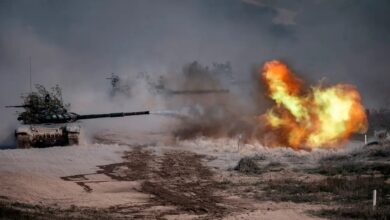
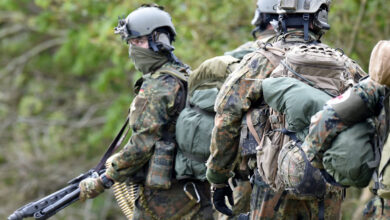
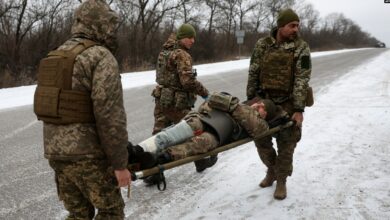
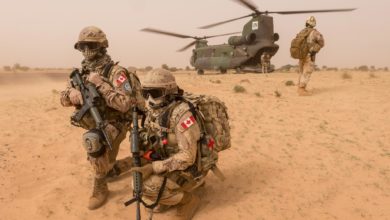


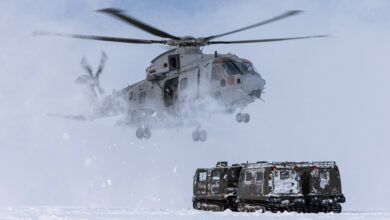

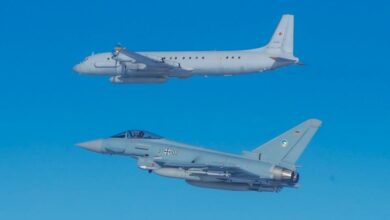

3 Comments